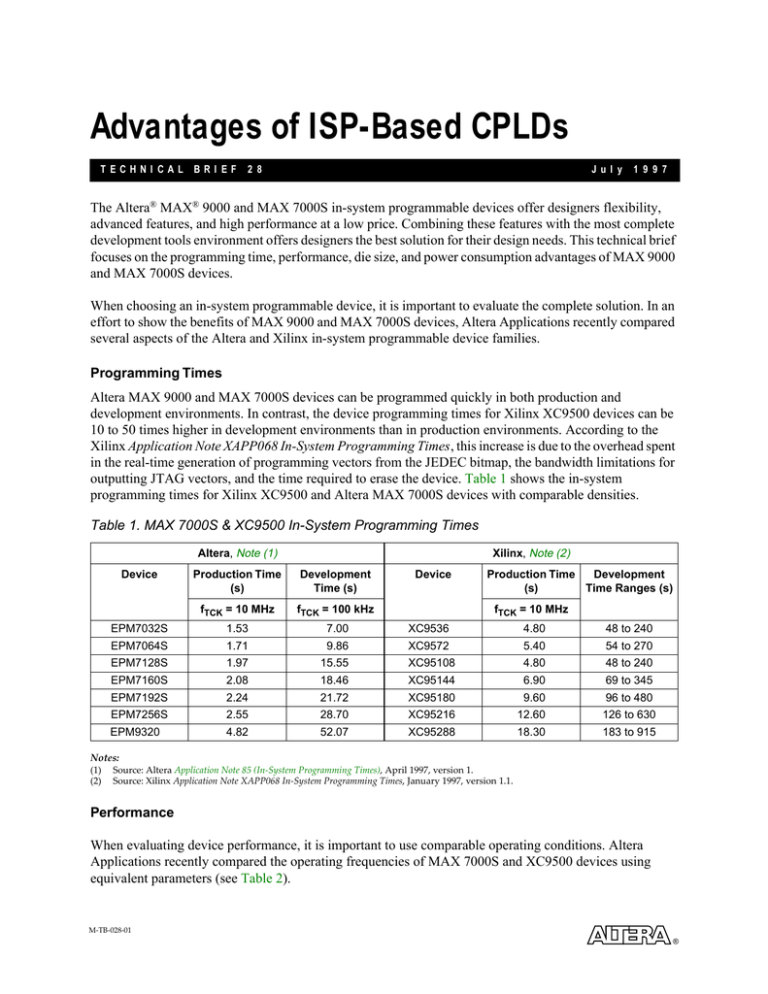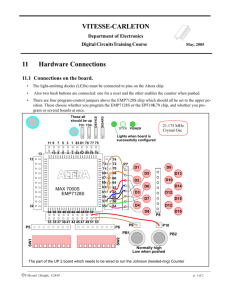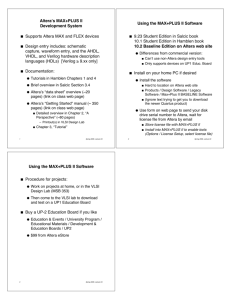
Advantages of ISP-Based CPLDs
TECHNI C AL
BR I E F
2 8
Ju ly
1 997
The Altera® MAX® 9000 and MAX 7000S in-system programmable devices offer designers flexibility,
advanced features, and high performance at a low price. Combining these features with the most complete
development tools environment offers designers the best solution for their design needs. This technical brief
focuses on the programming time, performance, die size, and power consumption advantages of MAX 9000
and MAX 7000S devices.
When choosing an in-system programmable device, it is important to evaluate the complete solution. In an
effort to show the benefits of MAX 9000 and MAX 7000S devices, Altera Applications recently compared
several aspects of the Altera and Xilinx in-system programmable device families.
Programming Times
Altera MAX 9000 and MAX 7000S devices can be programmed quickly in both production and
development environments. In contrast, the device programming times for Xilinx XC9500 devices can be
10 to 50 times higher in development environments than in production environments. According to the
Xilinx Application Note XAPP068 In-System Programming Times , this increase is due to the overhead spent
in the real-time generation of programming vectors from the JEDEC bitmap, the bandwidth limitations for
outputting JTAG vectors, and the time required to erase the device. Table 1 shows the in-system
programming times for Xilinx XC9500 and Altera MAX 7000S devices with comparable densities.
Table 1. MAX 7000S & XC9500 In-System Programming Times
Altera, Note (1)
Device
Xilinx, Note (2)
Production Time
(s)
Development
Time (s)
Device
Production Time
Development
(s)
Time Ranges (s)
fTCK = 10 MHz
fTCK = 100 kHz
EPM7032S
1.53
7.00
XC9536
4.80
48 to 240
EPM7064S
1.71
9.86
XC9572
5.40
54 to 270
EPM7128S
1.97
15.55
XC95108
4.80
48 to 240
EPM7160S
2.08
18.46
XC95144
6.90
69 to 345
EPM7192S
2.24
21.72
XC95180
9.60
96 to 480
EPM7256S
2.55
28.70
XC95216
12.60
126 to 630
EPM9320
4.82
52.07
XC95288
18.30
183 to 915
fTCK = 10 MHz
Notes:
(1)
(2)
Source: Altera Application Note 85 (In-System Programming Times), April 1997, version 1.
Source: Xilinx Application Note XAPP068 In-System Programming Times, January 1997, version 1.1.
Performance
When evaluating device performance, it is important to use comparable operating conditions. Altera
Applications recently compared the operating frequencies of MAX 7000S and XC9500 devices using
equivalent parameters (see Table 2).
M-TB-028-01
®
ALTERA MEGAFUNCTION PARTNERS PROGRAM
Table 2. Equivalent Performance Parameters
Altera
Parameter
Xilinx
Description
Parameter
Description
fCNT
Maximum internal global clock frequency
fCNT
Operating frequency for 16-bit counters
fACNT
Maximum internal array clock frequency
fSYSTEM
Internal operating frequency for generalpurpose system designs spanning multiple
function blocks
When compared under the same operating conditions, Altera MAX 7000S devices out-perform Xilinx
XC9500 devices (see Table 3). In addition, Altera’s performance advantage will increase with the future
release of the 5-ns EPM7032S devices, 6-ns EPM7128S devices, and 7.5-ns EPM7160S and EPM7192S
devices.
Table 3. MAX 7000S & XC9500 Device Performance
Device
tSU (ns)
tCO (ns)
fCNT (MHz)
fSYSTEM (MHz)
EPM7032S
4
3.5
178.6
178.6
EPM7064S
5
4
151.5
151.5
EPM7128S
5
4
151.5
151.5
EPM7160S
6
4.5
125
125
EPM7192S
6
4.5
125
125
EPM7256S
6
4.5
125
125
XC9536
4.5
4.5
125
100
XC9572
5.5
5.5
125
83
XC95108
5.5
5.5
125
83
XC95144
5.5
5.5
125
83
XC95180
6.5
6.5
111
67
XC95216
6.5
6.5
111
67
Die Size
Altera aggressively pursues the most advanced manufacturing processes, enabling designers to benefit from
the highest performance devices at the lowest price. For example, Altera has migrated its 128-macrocell
device offerings from a 0.8-micron, dual-layer metal process in 1992, to a 0.5-micron, triple-layer metal
process in 1997. Migrations allow Altera to continue providing extremely competitive prices. In contrast,
the Xilinx XC9500 device family is manufactured on a 0.6-micron, dual-layer metal process. Figure 1
compares the die sizes of the XC95108, EPM7128E, and EPM7128S devices.
2
Altera Corporation
Figure 1. Die Size Comparison
XC95108
EPM7128E
EPM7128S
1.0
9707
0.78
9532
0.35
9706
Relative Die Size:
Date Code:
In addition, Altera plans to manufacture the next-generation product-term based family, Michelangelo, on
a 0.35-micron, quad-layer metal process beginning in early 1998. Thus, Altera continues to aggressively
pursue the most efficient manufacturing process.
Power Consumption
The Altera MAX 7000S device family offers a power-efficient interconnect structure. In fact, MAX 7000S
devices consume less power than XC9500 devices when operating under similar conditions (see Figure 2).
Figure 2. MAX 7000S & XC9500 Power Consumption
Note (1)
250
XC95108, Note (2)
200
ICC Supply
Current (mA)
EPM7128S, Note (3)
150
XC95108, Note (4)
100
EPM7128S, Note (5)
50
0
0
25
Frequency (MHz)
50
Notes:
(1) Source: Xilinx 1996 Data Book and Altera 1996 Data Book.
(2) Power consumption for an XC95108 device set for high performance.
(3) Power consumption for an EPM7128S device with the Turbo Bit™ logic option turned on.
(4) Power consumption for an XC95108 device set for low performance.
(5) Power consumption for an EPM7128S device set with the Turbo Bit logic option turned off.
Altera Corporation
3
References
The following documents provide more detailed information. The part numbers are in parentheses.
■
■
■
■
MAX 9000 Programmable Logic Device Family Data Sheet (A-DS-M9000-04)
MAX 7000 Programmable Logic Device Family Data Sheet (A-DS-M7000-04)
In-System Programmability Handbook (M-HB-ISP-01)
In-System Programmability CD-ROM (M-CD-ISP-02)
You can request these documents from:
■
■
■
Altera Literature Services at (888) 3-ALTERA
World-wide web site at http://www.altera.com
Your local Altera sales representative
Copyright 1997 Altera Corporation. Altera, MAX, MAX 9000, MAX 7000, MAX 7000S, EPM7032S, EPM7064S, EPM7128S, EPM7160S,
EPM7192S, EPM7256S, EPM9320A, and Turbo Bit are trademarks and/or service marks of Altera Corporation in the United States and/or
other countries. Other brands or products are trademarks of their respective holders. All rights reserved.
4
®
Altera Corporation




